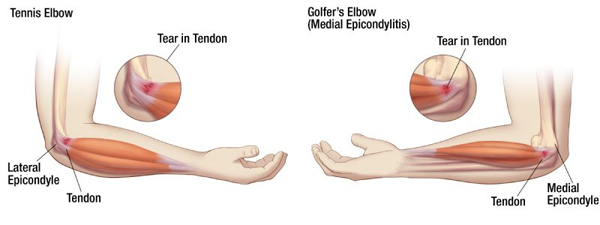
Tennis or Golfers elbow?
So you have a pain in your elbow. Maybe you play golf AND tennis. Which is it??
Roughly speaking Golfer’s elbow affects the inner elbow; bending the wrist and fingers inward towards your palm is often painful. If you wince or get pain when you strike a divot (now I mean physical pain! not the pain of playing badly!) then this can be a sign that there is a problem.
Tennis elbow on the other hand often causes pain in the outer, bony part of the elbow and can make grasping or holding an object painful, even something as light as a cup of tea.
Now obviously at this point I have to recommend getting a proper diagnosis. As I mentioned in my previous article about Tennis Elbow there are a lot of other things that can feel like Tennis or Golfers elbow but actually aren’t. And if it isn’t your elbow you can treat it and rest it and do all kinds of clever things but never get a good result.
Top Tips:
- Reduce grip size – this is helpful for both golf clubs and tennis racquets.
- Get a lesson with a pro to check your swing. Altering your technique might resolve the problem completely.
- Get a proper diagnosis with a professional
What next?
Both Tennis and Golfers elbow are tendon issues. So the treatment programs will be similar.
One of the biggest issues with tendon injuries (wherever they are in the body!) is that, due to a poor blood supply, they are really slow to heal. 9 – 12 months is a typical time scale. That’s a long time to be off your sport. And, just to compound the problem if you rest completely, scar tissue can build up on the tendon which is an even more complicated problem to have to solve.
So what to do?
- Magnetic Resonance Therapy – increases blood flow to the bone and attached tendon so healing time becomes weeks instead of months.
- Gentle stretching and exercise – this is your homework, I will design and teach you an exercise program to keep you moving. And to do as a warm up before you play
- Ultrasound and gentle manual therapy – this helps prevent scar tissue build up and keeps the tendons supple to heal.
With a proper diagnosis and a personalised treatment plan you don’t need to be off your sport for long!

One Comment